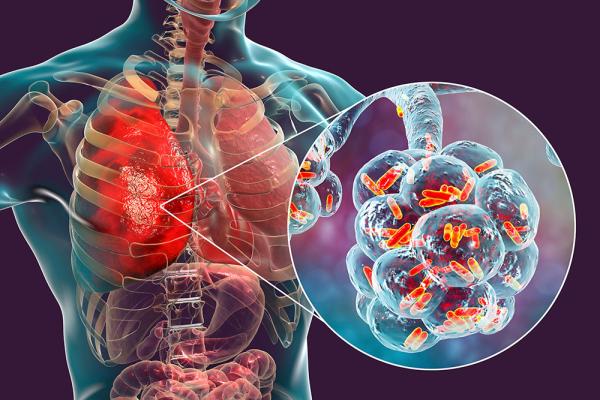Seeking Antibiotic Alternatives to Annihilate Infections
IRP’s Darryl Zeldin Investigates New Ways to Combat Bacterial Pneumonia

As antibiotic medications become less effective against many bacterial infections, IRP researchers are seeking other ways to combat infectious invaders.
Our immune system is supposed to block infections like pneumonia, and in most instances, it does. Even so, nearly 1 million Americans each year become sick enough from pneumonia to require a visit to the hospital, and for about 50,000, the lung infection is deadly.
Multiple types of infectious organisms can cause pneumonia, and doctors use antibiotics to treat cases caused by bacteria. Unfortunately, bacteria are resilient organisms that have waged an evolutionary battle against our antibiotics ever since penicillin was first discovered, leading to alarming rates of antibiotic-resistant infections. It’s no wonder, then, that the public health community calls attention to this life-threatening conundrum each November during Antibiotic Awareness Week.
“It’s this kind of dog-and-cat fight where the bacteria are trying to outsmart people’s defenses against infection and become more resistant to antibiotics while people are trying to develop newer medicines that outsmart the bacteria,” says IRP senior investigator Darryl Zeldin, M.D. “Now, there’s a significant proportion of bacterial pneumonia that is resistant to most, if not all, of the commonly used antibiotics.”

In any large population of bacteria, a tiny set of individuals will be resistant to particular antibiotics. Widespread use of antibiotics helps that tiny population multiply and thrive by eliminating its competitors, thereby increasing the prevalence of antibiotic resistance.
Dr. Zeldin and his associates are looking for ways to strengthen our immune system so it can do a better job of winning the battle against invading pneumonia bacteria without the help of antibiotics. His team recently took a major step towards that goal when they discovered a way that the immune system rids the lungs of the bacteria responsible for ‘streptococcal’ pneumonia.
As a practicing physician specializing in the treatment of lung ailments, Dr. Zeldin is well-suited to investigate how the immune system works in the lungs. A key aspect of that system is a careful balance between inflammation-inducing immune cells and molecules that tamp down inflammation, which must work in harmony to fight infections without going overboard and causing harm.
As COVID-19 ravaged lungs around the world in 2020 and 2021, Dr. Zeldin and his research team discovered that an enzyme naturally present in the body, called soluble epoxide hydrolase (sEH), can dampen the effects of potent anti-inflammatory molecules called epoxyeicosatrienoic acids (EETs). EETs are found throughout the body, and the more abundant they are, the greater their ability to block infection-fighting immune cells called macrophages from doing their job finding, catching, and destroying pathogens as they maneuver through the lungs.

Pneumonia bacteria cause illness by infecting tiny air sacs in the lungs called alveoli.
“Your macrophages are constantly scavenging the airways and getting rid of bacteria and viruses and other things that are there,” Dr. Zeldin says. “That’s why you don't have pneumonia all the time.”
After making that initial observation about sEH’s effects on EETs, Dr. Zeldin teamed up with IRP senior investigator Michael Fessler, M.D., who was looking for ways to utilize a new mouse model of bacterial pneumonia that his lab had developed. Their goal: to see if manipulating levels of sEH and EETs affected the severity of infection in those animals.1
“Lo and behold, we found when we gave the mice a drug to inhibit sEH, the mice didn’t do as well — they didn’t clear the infection,” Dr. Zeldin recalls. Likewise, knocking out the gene that codes for sEH also prevented recovery. “In short, we found if we inhibited the sEH, EET levels went up, and the ability of the macrophages to clear the bacteria was reduced. On the other hand, when we blocked the EETs, the macrophages were better able to do their job and clear the bacteria.”
“In a nutshell, we discovered this pathway whereby we can manipulate immune cells in the infected person and make them more aggressive in recognizing, capturing, and killing streptococcal pneumonia in mouse and cell models,” Dr. Zeldin continues. “If we translate this to humans, we could possibly create a drug that inhibits EETs and be used to augment the effectiveness of antibiotics in treating pneumonia.”
After several years of follow-up experiments with other strains of bacteria, Dr. Zeldin now believes the influences of sEH and EETs are specific to streptococcal pneumonia. However, that doesn’t mean there aren’t other bodily processes that have a similar effect on other strains of bacteria — something Dr. Zeldin hopes to explore in the future.
For now, a California-based pharmaceutical company called EicOsis is running clinical trials to test drugs that inhibit sEH in patients as a way to treat pain and inflammation rather than pneumonia. Meanwhile, further laboratory research aimed at better understanding and harnessing the interplay between sEH and EETs may not only lead to new treatments for bacterial pneumonia, but also better ways to diagnose and prevent it.

Dr. Darryl Zeldin
“We may be able to recognize which people might be more susceptible to pneumonia infection by looking at how well the macrophages in their lungs are working or by looking for genetic mutations that weaken the ability of these macrophages to function,” Dr. Zeldin says. “It may help identify who needs to be more vigilant — who should go to the doctor when they first develop a cough or who should start antibiotic treatment earlier. Or, if we are successful in developing an inhibitor that stops EETs in humans, we might give it to people who have a genetic susceptibility to severe cases of pneumonia.”
The prospect of countering pneumonia infections early on with treatments that circumvent the need for antibiotics is incredibly enticing in a world increasingly teeming with antibiotic-resistant bacteria.
“Resistance to antibiotics for pneumonia is more and more common now, and experts are really concerned because it has such a high mortality rate and because it affects people who are the most vulnerable in our society: young kids, the elderly, people in nursing homes, and people with underlying lung conditions,” Dr. Zeldin says. “There’s still a lot of work to be done before this kind of discovery makes it into the clinic, but as antibiotic resistance becomes more of a problem, the hope is that this approach is something the medical community will embrace.”
References:
[1] Li H, Bradbury JA, Edin ML, Graves JP, Gruzdev A, Cheng J, Hoopes SL, DeGraff LM, Fessler MB, Garantziotis S, Schurman SH, Zeldin DC. sEH promotes macrophage phagocytosis and lung clearance of Streptococcus pneumoniae. J Clin Invest. 2021 Nov 15;131(22):e129679. doi: 10.1172/JCI129679.
Subscribe to our weekly newsletter to stay up-to-date on the latest breakthroughs in the NIH Intramural Research Program.
Related Blog Posts
This page was last updated on Thursday, January 4, 2024
